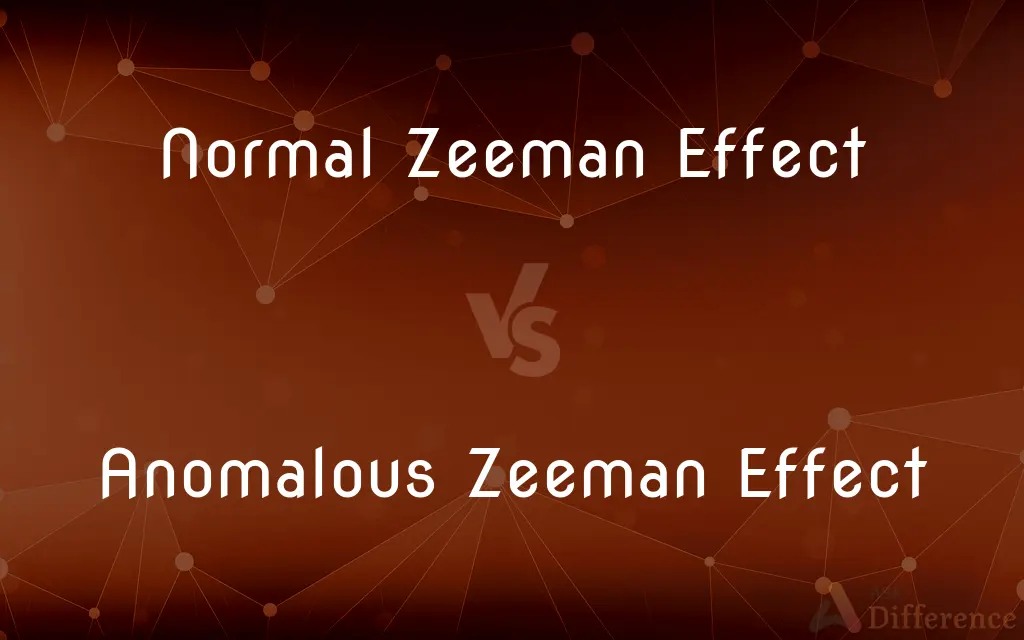Normal Zeeman Effect vs. Anomalous Zeeman Effect — What's the Difference?
Edited by Tayyaba Rehman — By Fiza Rafique — Published on December 24, 2023
Normal Zeeman Effect splits spectral lines into equally spaced components due to the magnetic field. Anomalous Zeeman Effect shows uneven splitting due to both the magnetic field and electron spin.

Difference Between Normal Zeeman Effect and Anomalous Zeeman Effect
Table of Contents
ADVERTISEMENT
Key Differences
The Normal Zeeman Effect pertains to the splitting of spectral lines in the presence of a magnetic field. The Anomalous Zeeman Effect, on the other hand, involves uneven splitting caused by both the magnetic field and electron spin.
When a spectral line, due to the Normal Zeeman Effect, undergoes splitting, it divides into equidistant components. The Anomalous Zeeman Effect displays a different behavior; spectral lines split in a manner that is not uniform, owing to the intrinsic electron spin.
To differentiate further, the Normal Zeeman Effect arises because of the orbital motion of electrons. Meanwhile, the Anomalous Zeeman Effect is a combined result of both the electron's orbital motion and its intrinsic spin.
One can observe the Normal Zeeman Effect when the net spin of the electrons in the atom is zero. For the Anomalous Zeeman Effect to be evident, the net spin of the electrons should not be zero, leading to complex and uneven spectral splitting.
For magnetic field effects on spectral lines, the Normal Zeeman Effect demonstrates simplicity and predictability. The Anomalous Zeeman Effect, conversely, is more intricate due to the interplay of the magnetic field and electron spin.
ADVERTISEMENT
Comparison Chart
Cause
Orbital motion of electrons
Orbital motion + Electron spin
Spectral Line Splitting
Equidistant components
Uneven components
Electron Spin Involvement
No
Yes
Typical Electron Spin
Net spin is zero
Net spin is not zero
Complexity
Simpler, predictable
Intricate due to electron spin & magnetic field
Compare with Definitions
Normal Zeeman Effect
A phenomenon where spectral lines split into equally spaced components due to a magnetic field.
Observing the Normal Zeeman Effect helped researchers understand the influence of magnetic fields on light spectra.
Anomalous Zeeman Effect
The division of spectral lines influenced by the combined effects of electron's orbital motion and spin.
The Anomalous Zeeman Effect manifests when both the electron motion and its intrinsic spin come into play.
Normal Zeeman Effect
A magnetic interaction resulting in equidistant spectral line components.
Thanks to the Normal Zeeman Effect, we can predict the spectral patterns when exposed to magnetic fields.
Anomalous Zeeman Effect
A magnetic interaction resulting in complex spectral line components due to electron spin.
The Anomalous Zeeman Effect provides insight into the intricate behaviors of electrons in magnetic fields.
Normal Zeeman Effect
A magnetic field-induced effect causing uniform spectral line splitting.
The uniformity of the split lines in the spectrum confirmed the presence of the Normal Zeeman Effect.
Anomalous Zeeman Effect
A phenomenon where spectral lines split unevenly due to both a magnetic field and electron spin.
The Anomalous Zeeman Effect complicates spectral readings by introducing uneven splits.
Normal Zeeman Effect
The division of spectral lines owing to the electron's orbital motion in a magnetic field.
The Normal Zeeman Effect reveals how external magnetic fields affect atomic transitions.
Anomalous Zeeman Effect
A magnetic field-induced effect causing non-uniform spectral line splitting.
Unlike its normal counterpart, the Anomalous Zeeman Effect results in unpredictable spectral patterns.
Normal Zeeman Effect
The response of spectral lines to magnetic fields without considering electron spin.
Without the influence of electron spin, the Normal Zeeman Effect is clearly evident in certain atoms.
Anomalous Zeeman Effect
The response of spectral lines to magnetic fields, considering the influence of electron spin.
With the involvement of electron spin, the Anomalous Zeeman Effect becomes evident in certain spectral readings.
Common Curiosities
What is the primary cause of the Normal Zeeman Effect?
The primary cause is the orbital motion of electrons in a magnetic field.
How does the Anomalous Zeeman Effect differ from the Normal Zeeman Effect in terms of spectral splitting?
The Anomalous Zeeman Effect leads to uneven splitting due to both magnetic field and electron spin.
Can the Normal Zeeman Effect account for electron spin?
No, the Normal Zeeman Effect does not account for electron spin.
What causes the complexity in the Anomalous Zeeman Effect?
The complexity arises from the interplay of the magnetic field and electron spin.
Is the Anomalous Zeeman Effect predictable?
It's more intricate and less straightforward than the Normal Zeeman Effect due to electron spin.
Why is the Anomalous Zeeman Effect termed "anomalous"?
It's termed "anomalous" due to its unexpected and uneven splitting compared to the "normal" equidistant splitting.
Do all elements exhibit the Normal Zeeman Effect when exposed to a magnetic field?
Not all; it depends on the atomic structure and net electron spin.
Does the Anomalous Zeeman Effect always result in uneven components?
Yes, due to the combined effects of the magnetic field and electron spin.
What kind of atoms typically show the Normal Zeeman Effect?
Atoms with a net electron spin of zero.
How does electron spin play a role in the Anomalous Zeeman Effect?
Electron spin introduces additional magnetic moments, leading to more complex splitting patterns.
Are the spectral line components equally spaced in the Normal Zeeman Effect?
Yes, they are equally spaced.
Can we observe both the Normal and Anomalous Zeeman Effects in the same atom?
It depends on the atomic state and the transitions being observed.
Does the strength of the magnetic field influence the Normal Zeeman Effect?
Yes, the strength of the magnetic field affects the degree of splitting.
Can the Anomalous Zeeman Effect provide insights into electron behaviors?
Yes, it reveals the intricate interplay of electron orbital motion and spin in magnetic fields.
Which Zeeman Effect is more commonly observed in laboratory settings?
It depends on the material and conditions, but both effects can be observed under appropriate circumstances.
Share Your Discovery

Previous Comparison
Greek Orthodox vs. Roman Catholics
Next Comparison
Renewable Resources vs. Non-renewable ResourcesAuthor Spotlight
Written by
Fiza RafiqueFiza Rafique is a skilled content writer at AskDifference.com, where she meticulously refines and enhances written pieces. Drawing from her vast editorial expertise, Fiza ensures clarity, accuracy, and precision in every article. Passionate about language, she continually seeks to elevate the quality of content for readers worldwide.
Edited by
Tayyaba RehmanTayyaba Rehman is a distinguished writer, currently serving as a primary contributor to askdifference.com. As a researcher in semantics and etymology, Tayyaba's passion for the complexity of languages and their distinctions has found a perfect home on the platform. Tayyaba delves into the intricacies of language, distinguishing between commonly confused words and phrases, thereby providing clarity for readers worldwide.











































